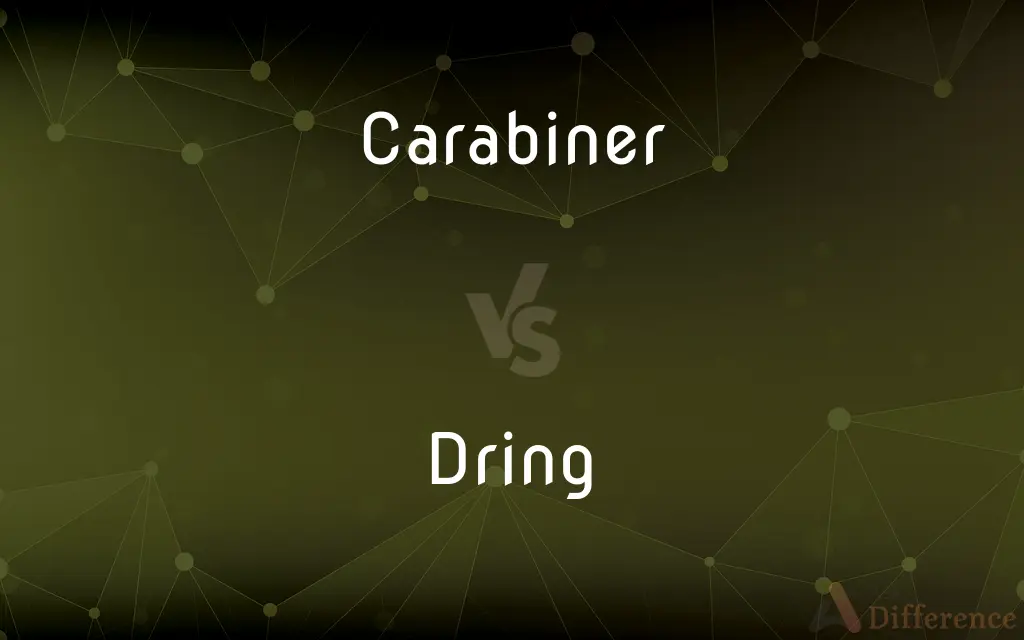Carabiner vs. Dring — What's the Difference?
Edited by Tayyaba Rehman — By Maham Liaqat — Updated on April 25, 2024
A carabiner is a metal loop with a spring-loaded gate used for quickly and reversibly connecting components, primarily in safety-critical systems like climbing. A D-ring is a simple metal ring shaped like a "D", used as attachment point in various gear.

Difference Between Carabiner and Dring
Table of Contents
ADVERTISEMENT
Key Differences
Carabiners are versatile metal connectors commonly used in climbing and mountaineering to quickly and securely attach ropes, harnesses, and other gear. They feature a spring-loaded gate that can be quickly opened and closed. In contrast, D-rings are static metal rings shaped like the letter "D" and are often used in fashion, luggage, and equestrian equipment to attach items or straps but lack any moving parts.
While carabiners are specifically designed to bear heavy loads and are made from materials like aluminum or steel for strength and durability, D-rings are typically not load-bearing and are used more for their functionality as attachment points rather than for strength. This makes carabiners suitable for safety applications whereas D-rings are more for utility.
Carabiners come in various shapes including oval, D-shaped, and asymmetric D-shaped, each designed to optimize strength, weight, and gate opening size. D-rings, however, are generally uniform in shape but may vary in size and thickness according to their intended use, focusing more on versatility than specialized performance.
In terms of security, carabiners often feature locking mechanisms that prevent the gate from opening accidentally, crucial in climbing and industrial applications. D-rings do not have any locking features, which makes them simpler but less secure for critical loads.
The choice between a carabiner and a D-ring also depends on the specific requirements of the task. Carabiners are essential for dynamic systems where quick and secure manipulation is necessary, while D-rings are suitable for static systems where items are seldom removed or replaced.
ADVERTISEMENT
Comparison Chart
Description
Metal loop with a spring-loaded gate
Metal ring shaped like a "D"
Primary Use
Climbing, safety applications
Luggage, equestrian gear, fashion
Material
Aluminum, steel (for strength and durability)
Metal (varies, often not specified for strength)
Load-bearing Capacity
High, designed for critical loads
Low, not typically used for heavy loads
Locking Mechanism
Often features a locking gate
No locking mechanism
Shape Variability
Various shapes to optimize performance
Generally uniform but varies in size
Safety Critical
Yes, crucial for user safety
No, more for utility
Compare with Definitions
Carabiner
A metal loop with a spring-loaded gate, used particularly in climbing.
He attached his rope to the harness using a sturdy carabiner.
Dring
A D-shaped metal ring used as a simple attachment point.
The dog's leash was clipped to a D-ring on its collar.
Carabiner
A durable tool made from high-strength materials like aluminum.
The climber's carabiner was lightweight yet capable of supporting significant weight.
Dring
A common component in equestrian equipment for tack attachment.
The saddle had several D-rings for attaching gear.
Carabiner
A connecting device used in safety-critical systems to bear loads.
The rescue team used carabiners to secure their equipment.
Dring
A non-load-bearing ring used in bags and clothing for attaching accessories.
She attached her keys to the D-ring inside her backpack.
Carabiner
A quick-release mechanism ideal for dynamic environments.
Carabiners on the firefighter's gear allow for rapid deployment.
Dring
A utility ring found in many everyday items for functional purposes.
The photographer's bag was fitted with D-rings for extra attachments.
Carabiner
A versatile connector used in various outdoor and industrial applications.
Carabiners are also handy for organizing camping gear.
Dring
A straightforward, uncomplicated design used widely in fashion.
D-rings are often used for belt loops and strap adjustments on clothing.
Carabiner
A carabiner or karabiner () is a specialized type of shackle, a metal loop with a spring-lo bandolier black aded gate used to quickly and reversibly connect components, most notably in safety-critical systems. The word is a shortened form of Karabinerhaken (or also short Karabiner), a German phrase for a "spring hook" used by a carbine rifleman, or carabinier, to attach his carabin to a belt or [[]].
Dring
Dring may refer to:
Carabiner
An oblong metal ring with a hinged and spring-loaded gate, used in activities such as mountaineering to connect a running rope to another piece of equipment.
Dring
To press; squeeze; crowd; push.
Carabiner
A metal link with a gate that can open and close, generally used for clipping ropes to anchors or other objects.
Dring
A throng; crowd.
Carabiner
An oblong metal ring with a spring clip; used in mountaineering to attach a rope to a piton or to connect two ropes
Dring
A narrow passage.
Common Curiosities
How do I choose the right carabiner for my activity?
Choosing the right carabiner involves considering the load it needs to support, the environment it will be used in, and specific features like locking mechanisms or shape that best suit your needs.
What materials are D-rings made from?
D-rings can be made from various metals such as steel, brass, or aluminum, depending on their intended use, with some designed for lightweight applications and others for more decorative purposes.
Are carabiners only used in climbing?
While carabiners are essential in climbing, they are also widely used in other fields such as rescue operations, industrial work at heights, and even in theatrical rigging due to their strength and reliability.
What is the weight capacity of a typical carabiner?
The weight capacity of carabiners varies, but most are rated to handle between 20 to 50 kN (kilonewtons) which translates to about 2,000 to 5,000 kilograms of force.
Can D-rings be used for safety harnesses?
D-rings are often used in safety harnesses but in specific locations and contexts where direct load-bearing is not critical, such as attachment points for accessories.
Is there a specific way to attach a D-ring?
Attaching a D-ring typically involves sewing it onto fabric or threading it onto a strap, depending on the application, with no special tools required.
How should I maintain my carabiner?
Regular maintenance of a carabiner includes cleaning it from dirt and debris, checking for signs of wear or damage, ensuring the gate functions smoothly, and occasionally lubricating the gate mechanism if necessary.
Can D-rings be customized for specific needs?
Yes, D-rings can be customized in terms of size, material, and finish to suit specific needs, particularly in custom manufacturing or fashion design.
What is the cost difference between carabiners and D-rings?
Generally, carabiners are more expensive than D-rings due to their complex design and the higher safety standards they must meet.
Are there different types of D-rings for different applications?
Yes, there are variations in D-rings such as heavy-duty D-rings for more robust applications and lightweight or thin D-rings for fashion or light-use applications.
How does the locking mechanism on a carabiner work?
Locking mechanisms on carabiners can be twist-lock, screw-lock, or auto-lock, designed to prevent the gate from opening accidentally during use.
What are the common failure modes of carabiners?
Common failure modes include gate failure, cracking under excessive load, or wear and corrosion that undermines the metal’s integrity. Regular inspection helps to mitigate these risks.
What safety certifications should I look for in a carabiner?
Look for certifications from organizations such as the UIAA (International Climbing and Mountaineering Federation) or CE (European Conformity) to ensure that the carabiner meets safety standards.
Can I use a D-ring in marine applications?
D-rings used in marine applications should be made from materials resistant to corrosion, such as stainless steel or brass, to prevent degradation.
How do environmental conditions affect the use of carabiners and D-rings?
Carabiners may require specific considerations for corrosion resistance in harsh environments, whereas D-rings are less susceptible but still need to be chosen based on the material for certain conditions.
Share Your Discovery

Previous Comparison
Mixer vs. Chaser
Next Comparison
Use vs. HarnessAuthor Spotlight
Written by
Maham LiaqatEdited by
Tayyaba RehmanTayyaba Rehman is a distinguished writer, currently serving as a primary contributor to askdifference.com. As a researcher in semantics and etymology, Tayyaba's passion for the complexity of languages and their distinctions has found a perfect home on the platform. Tayyaba delves into the intricacies of language, distinguishing between commonly confused words and phrases, thereby providing clarity for readers worldwide.














































